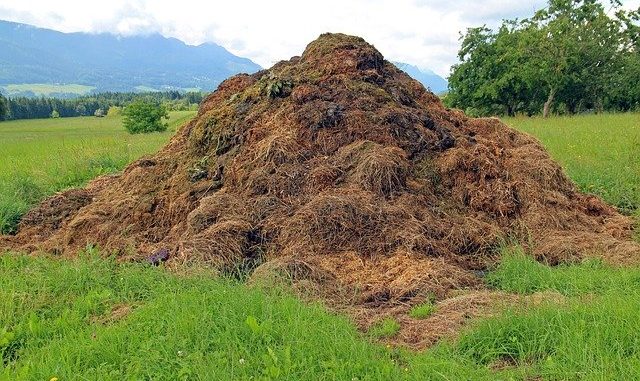
Home composting which I ‘posted’ on briefly earlier, is a form of solid-state fermentation (SSF) whereby the substrate is moist enough to support the growth of micro-organisms without the visible appearance of water between the particles. The technology is generally much more controlled than in home composting which is very much unstructured at the whim of the gardener.
The process of SSF has been widely applied for both the small-scale study (Hölker et al., 2004) and large-scale manufacture of food materials such as koji in Japan, for drugs, antibiotics like penicillin (Barrios-Gonzales et al., 1988) and other intermediates for further manufacturing. One of the most useful has been the production of enzymes (Singh et al., 2008). There are some very comprehensive reviews covering its application (Couto and Sanroán, 2006; Pandey et al., 2008).
The benefits are generally a high productivity rate with minimal technological sophistication which keeps further processing costs much lower than a liquid fermentation system. The other benefits also mean being to use certain physiological states for micro-organisms not available elsewhere. Water is also limited and a high product concentration is possible. Enzyme production looks a viable proposition, especially in the production of pectinases from fruit and cellulases for either breaking down lignin or generating bioethanol. Developing the theme further, I’m looking at ways to use food waste as a substrate source and this process offers some potential. Anybody interested in developing the ideas further ?
What Is SSF?
SSF is a process which a microorganism is grown in or on a solid-state medium or matrix. Its growth is most often determined by humidity as in the moisture level of the substrate and the surrounding air. The key difference is the absence of any free water as in a conventional liquid fermentation. The presence of the solid matrix characterises the fermentation.
The main features are:-
- existence of solid particles which may or may not be porous
- solids, particularly ones with irregular shapes varying from perfect spheres to forms of all sorts of different shapes and sizes. They may be ranging from microencapsulated spheres through to straw fibres for example.
- generally heterogenous as a system
- A heterogenous system with gradients of temperature, oxygen, carbon dioxide, biomass etc. The mechanisms of heat and mass transfer are very different from a liquid fermentation.
- the biomass may not be isolated from the other parts of the solid matrix.
- the biomass grows in acknowledgment of the changes in of the fermentation system. The particle and bed porosity, the change in shape of the particles, the changes in air chaneling through the system will alter during fermentation and are not found in liquid fermentation systems
- The kinetics of the system cannot be determined by direct measurement of biomass but must rely on indirect methods of assessment. These might be cell morphology, cell composition, the presence of products, the development of heat and changes in temperature, levels of gas consumption and other proper variables.
- Moisture levels in the solid matrix which reflect water activity will also alter.
Fermenter design
At what ever level, a fermenter is designed with the following in mind:-
- A system guaranteeing freedom from contamination by the external milieu
- a system of temperature control
- a system of air supply with an air quality determined by % saturation regulation which allows air to serve as the heat transfer medium in some cases
- an agitation system which operates continuously or intermittently depending on the fermentation itself. It must enhance air flow but be designed in a way to minimise shear of the microorganism due to shear forces generated by mechanical agitation
The Respiration Quotient
Gas balances are used to determine the kinetics of metabolism. The respiration quotient is one of the key types.
Q is the amount of carbon dioxide produced divided by oxygen consumed.
The Role Of Air
The air supply plays three important roles in an aerobic SSF:-
- Provides the required amount of oxygen
- Transfers part of the heat produced during fermentation to the gas phase
- Removes carbon dioxide and other volatiles produced from the solid matrix.
Oxygen supply to the cells is vital in aerobic fermentation especially. The transference is represented by the gas-liquid mass transfer coefficient (Kla) which is established as the principal criterion of process scale-up.
References
Barrios-Gonzales, J., Tomasini, A., Viniegra-Gonzalez, G. and Lopez, L. (1988). (Eds.) Penicillin production by solid-state fermentation in bioconversion of Agro-industrial Raw Materials. Raimbault M. Orsrtom, Montpellier Fr. Pp. 39-51.
Couto S, R., Sanroman MA. (2006) Application of solid-state fermentation to food industry a review: J Food Eng. 76 pp. 291–302.
Hölker, U., Höfer, M., & Lenz, J. (2004). Biotechnology advantages of laboratory-scale solid-state fermentation with fungi. Appl. Microb. Biotechnol., 64, pp. 175–186.
Pandey, A., Soccol, C.R., Larroche, C. (Eds.) (2008) Current Developments in Solid-State Fermentation. Springer
Singh, S.K., Sczakas, G., Soccol, C.R., Pandey, A. (2008) Production of enzymes by solid-state fermentation. In: Current Developments in Solid-State Fermentation. Part 2 Springer pp. 183-204

You write about some really useful stuff. It has helped me think about composting and sustainability🧔